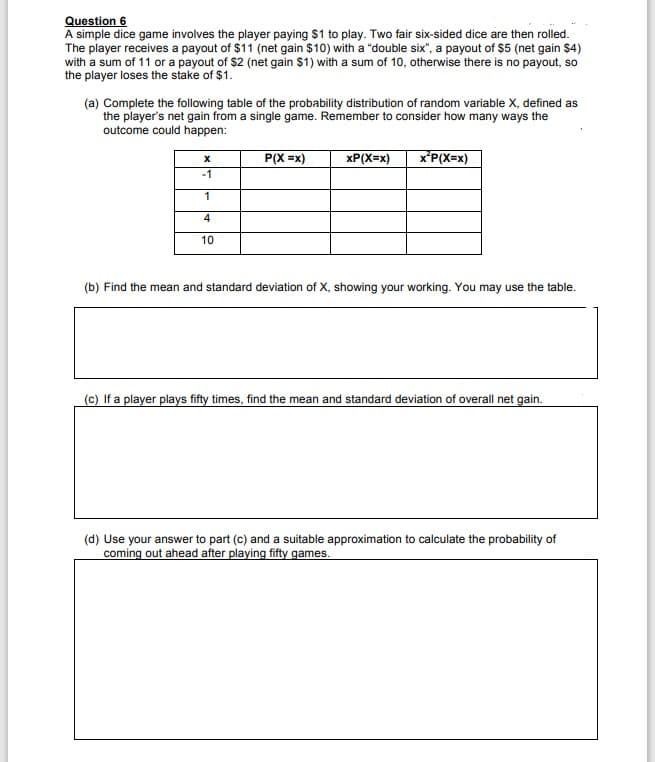Question 6 A simple dice game involves the player paying $1 to play. Two fair six-sided dice are then rolled. The player receives a payout of $11 (net gain $10) with a "double six", a payout of $5 (net gain $4) with a sum of 11 or a payout of $2 (net gain $1) with a sum of 10, otherwise there is no payout, so the player loses the stake of $1. (a) Complete the following table of the probability distribution of random variable X, defined as the player's net gain from a single game. Remember to consider how many ways the outcome could happen: P(X=x) xP(X=x) x*P(X=x) -1 1 4 10 (b) Find the mean and standard deviation of X, showing your working. You may use the table. (c) If a player plays fifty times, find the mean and standard deviation of overall net gain. (d) Use your answer to part (c) and a suitable approximation to calculate the probability of coming out ahead after playing fifty games.
Question 6 A simple dice game involves the player paying $1 to play. Two fair six-sided dice are then rolled. The player receives a payout of $11 (net gain $10) with a "double six", a payout of $5 (net gain $4) with a sum of 11 or a payout of $2 (net gain $1) with a sum of 10, otherwise there is no payout, so the player loses the stake of $1. (a) Complete the following table of the probability distribution of random variable X, defined as the player's net gain from a single game. Remember to consider how many ways the outcome could happen: P(X=x) xP(X=x) x*P(X=x) -1 1 4 10 (b) Find the mean and standard deviation of X, showing your working. You may use the table. (c) If a player plays fifty times, find the mean and standard deviation of overall net gain. (d) Use your answer to part (c) and a suitable approximation to calculate the probability of coming out ahead after playing fifty games.
A First Course in Probability (10th Edition)
10th Edition
ISBN:9780134753119
Author:Sheldon Ross
Publisher:Sheldon Ross
Chapter1: Combinatorial Analysis
Section: Chapter Questions
Problem 1.1P: a. How many different 7-place license plates are possible if the first 2 places are for letters and...
Related questions
Question
Part D please, thank you

Transcribed Image Text:Question 6
A simple dice game involves the player paying $1 to play. Two fair six-sided dice are then rolled.
The player receives a payout of $11 (net gain $10) with a "double six", a payout of $5 (net gain $4)
with a sum of 11 or a payout of $2 (net gain $1) with a sum of 10, otherwise there is no payout, so
the player loses the stake of $1.
(a) Complete the following table of the probability distribution of random variable X, defined as
the player's net gain from a single game. Remember to consider how many ways the
outcome could happen:
P(X =x)
xP(X=x)
x*P(X=x)
X
-1
1
4
10
(b) Find the mean and standard deviation of X, showing your working. You may use the table.
(c) If a player plays fifty times, find the mean and standard deviation of overall net gain.
(d) Use your answer to part (c) and a suitable approximation to calculate the probability of
coming out ahead after playing fifty games.
Expert Solution
This question has been solved!
Explore an expertly crafted, step-by-step solution for a thorough understanding of key concepts.
Step by step
Solved in 4 steps

Recommended textbooks for you

A First Course in Probability (10th Edition)
Probability
ISBN:
9780134753119
Author:
Sheldon Ross
Publisher:
PEARSON


A First Course in Probability (10th Edition)
Probability
ISBN:
9780134753119
Author:
Sheldon Ross
Publisher:
PEARSON
